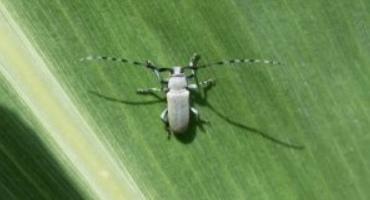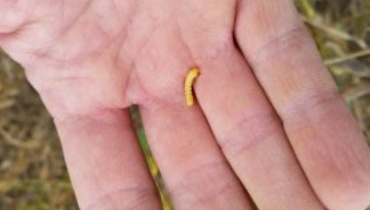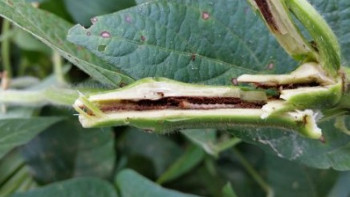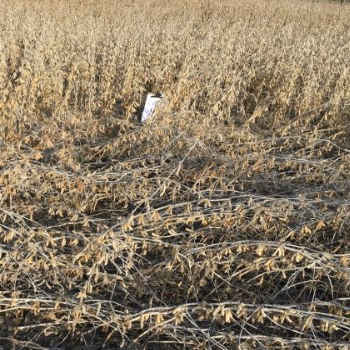By Nick Seiter
Many soybean growers have had problems with lodging at harvest this year. The primary culprit for this (as for many of our woes this fall) was the extended period of unfavorable weather that we have suffered. However, in parts of southern Illinois damage by the dectes stem borer contributed to this problem.
The adult dectes stem borer (Figure 1) is a “long-horned” beetle that can often be found in soybean and on other plants. The adult female chews a hole into the surface of the plant (usually at the petiole), and lays her eggs in the pith. This often results in individual petioles wilting or falling completely off of the plant, which is usually the first sign of an infestation. Upon hatching, the larva (Figure 2) tunnels throughout the stem and feeds on the pith. As the plant nears maturity, the larva moves into the base of the stem where it will spend the winter. As awful as the bored-out stem of a soybean plant looks after being attacked by dectes stem borer (Figure 3), economic losses only occur if this damage leads to lodging. When preparing to overwinter, larvae will often girdle the base of the stem, causing the plant to break off and leading to harvest difficulties and reduced yield (Figure 4). This insect has one generation per year, with the adults usually emerging from soybean residue beginning in late June in Illinois to start the cycle again.

Figure 1. An adult dectes stem borer at rest.

Figure 2. A larva of the dectes stem borer removed from a soybean stem
Insecticides are generally not recommended for control because the larvae are protected within the stem and the adults lay eggs over a long period of time in the summer (approximately mid-July through August in Illinois). While there appear to be some differences in varietal susceptibility, these differences are not well documented, and to my knowledge no soybean varieties have been characterized as resistant to dectes stem borer. However, there are some cultural management options available to producers:

Figure 3. Damage to the inside of a soybean stem caused by a dectes stem borer larva

Figure 4. Lodged soybeans due to dectes stem borer feeding (Photo: Eric Alinger, Dupont Pioneer)
- Monitoring. While there is no economic threshold established, finding adults at higher than average numbers will be the first indication of a problem. Note wilting or broken-off petioles, and split soybean stems toward the end of the season to gauge the level of infestation. In addition, examine soybean stems in lodged areas to determine if dectes stem borer was part of the problem. If you have never done so before and you are in southern Illinois, the results might surprise you.
- Timely harvest. Obviously, we would harvest on time every year in every field if we could. However, if you note fields that are infested with dectes stem borer, put those fields as early as possible on the priority list to reduce the potential for lodging.
- Soybean stubble. Destroying or burying soybean stubble in the fall reduces dectes numbers locally, but the adults readily move from their overwintering sites to surrounding fields. Areas with a lot of no-till production are likely to have more issues with dectes stem borer.
- Alternate hosts. Dectes stem borers feed on several other host plants, including sunflowers and giant ragweed. Areas with high populations of these plants could have higher populations of dectes stem borers as well. (As if you needed another reason to kill giant ragweed).
Source: illinois.edu